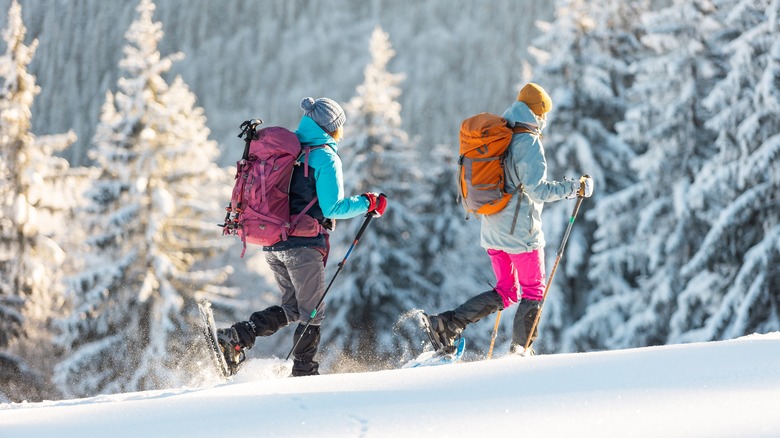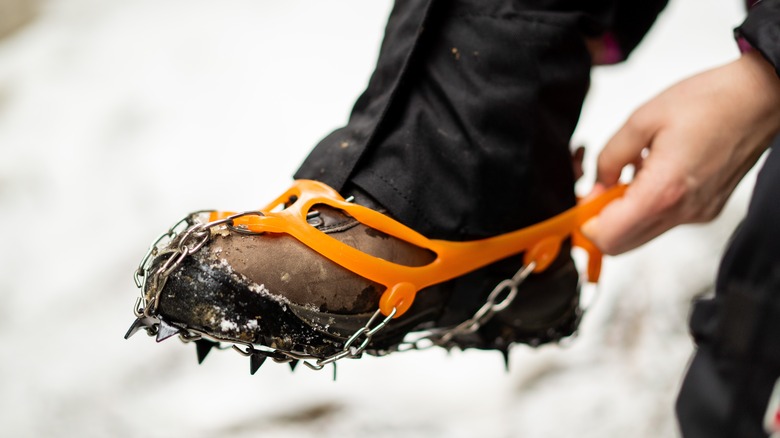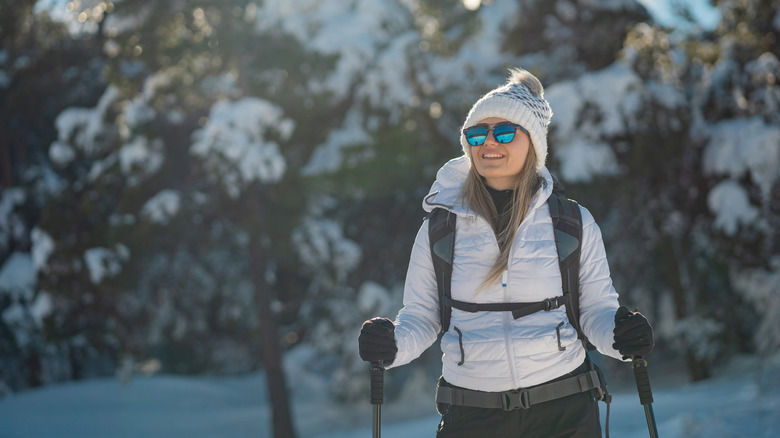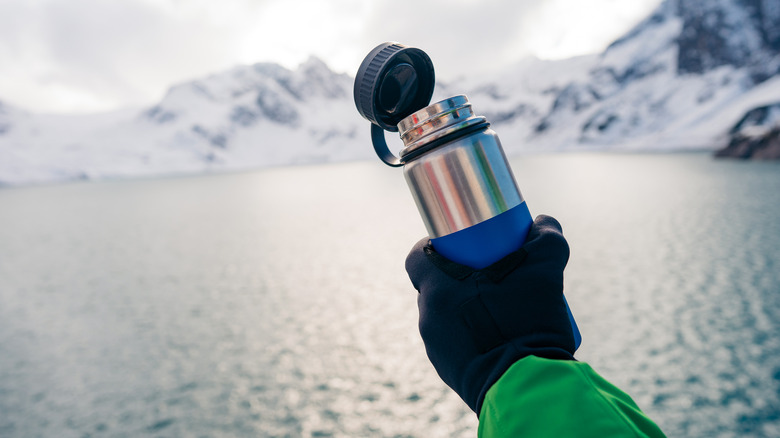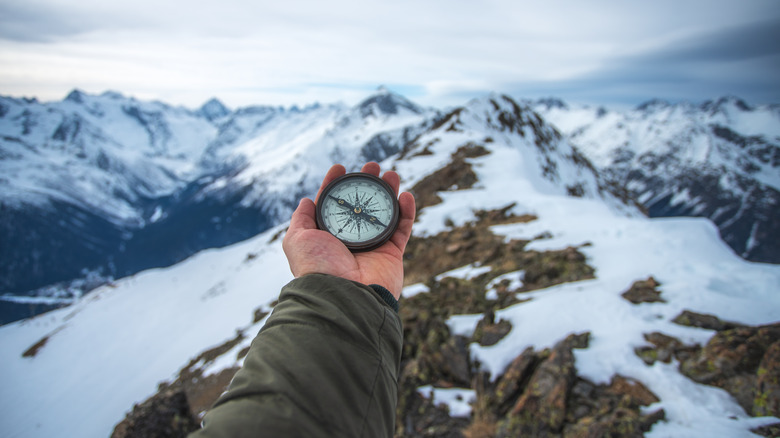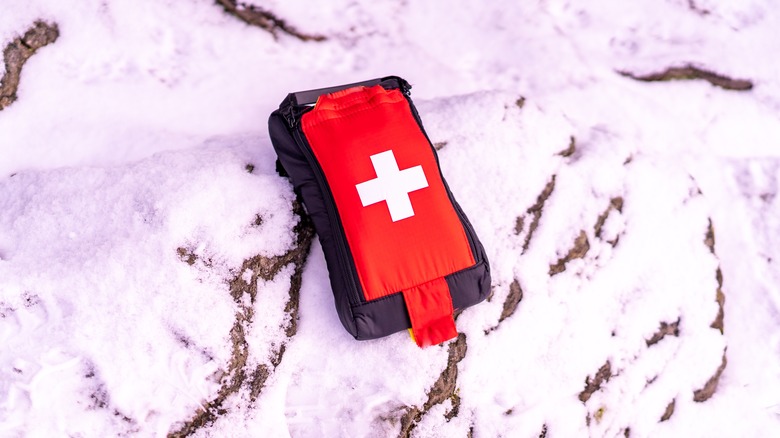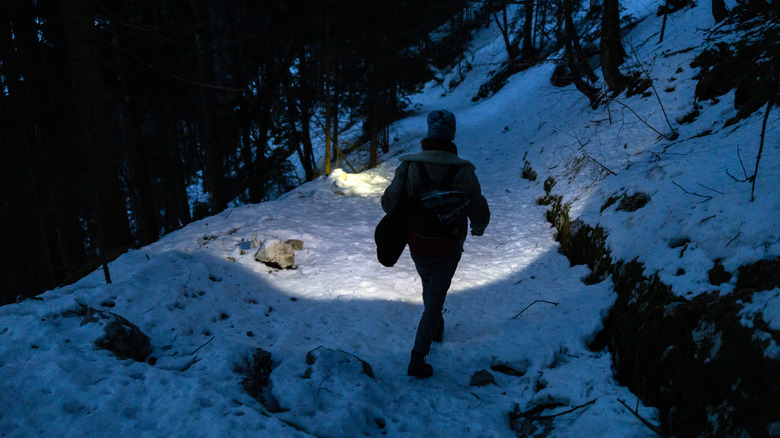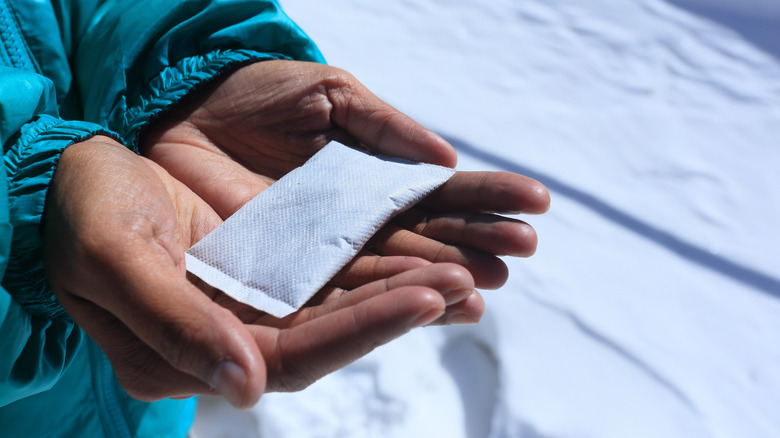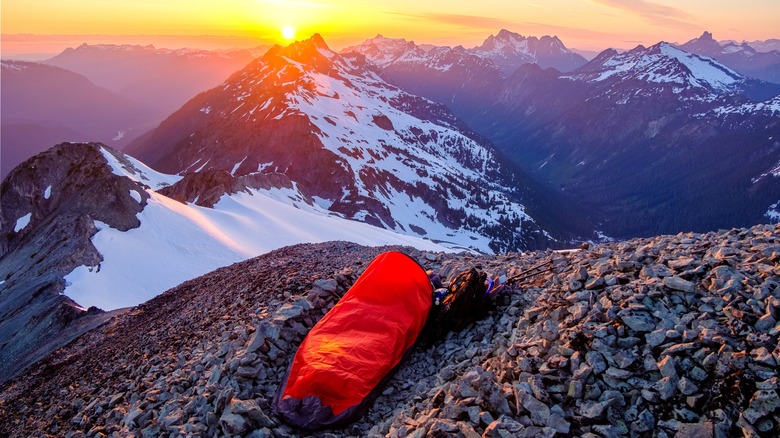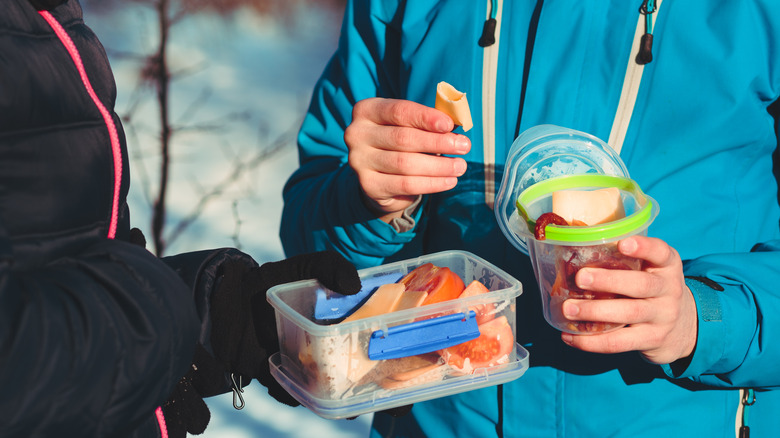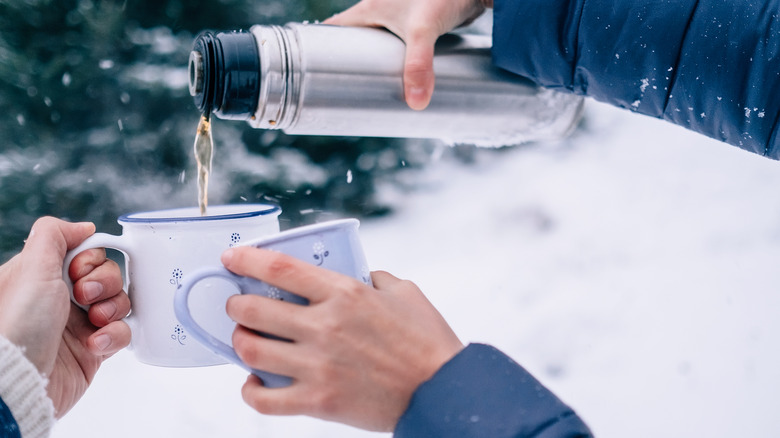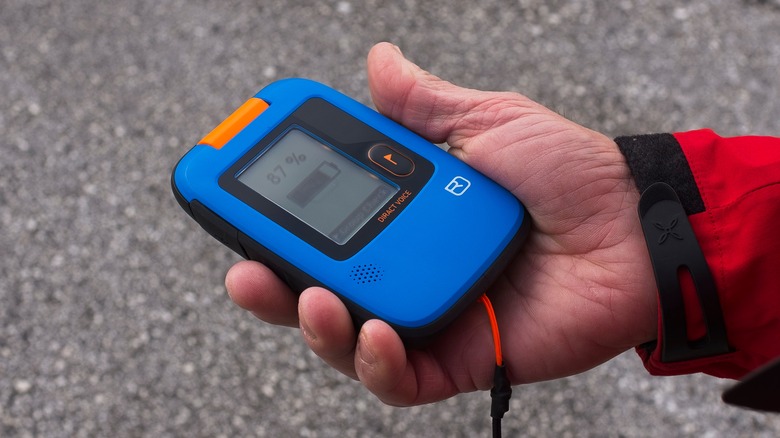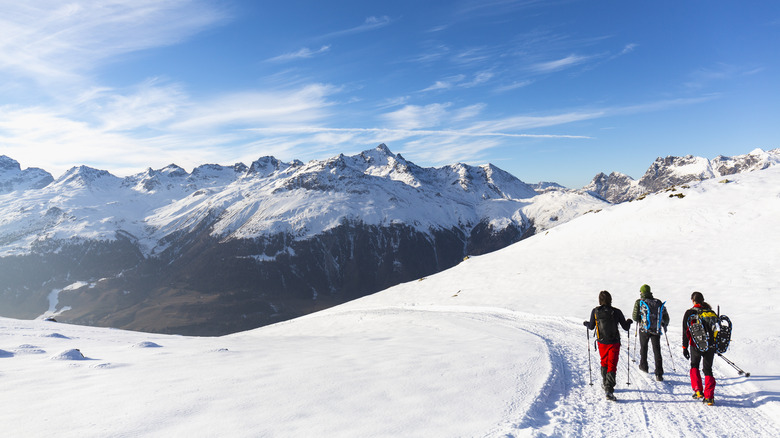12 Things To Pack In Your Winter Hiking Backpack
Snow-covered landscapes provide unique photography opportunities and winter-specific activities such as snowshoeing. Many animals also stay active in the winter, offering great opportunities for wildlife viewing. Needless to say, winter hiking unveils a serene and magical landscape, but it also demands careful preparation to tackle the challenges that the cold season brings. Whether you're a seasoned winter adventurer or a novice looking to explore the frosty trails, having the right hiking gear is paramount.
Pulling from a mix of personal experience, online hiker reviews, and advice from hiking experts, we've chosen 12 essential items you'll need to pack in your winter hiking backpack. In addition to dressing in warm layers and packing the essentials for your winter hike, you should also aim to stay safe when on the trail. Turning back when the weather takes a turn for the worst, keeping your hiking companions close, and letting others know of your plans ahead of time all ensure you can have a safe and fun winter adventure.
Packable insulated jacket
A packable, insulated jacket keeps your backpack light but offers extra warmth in an instant. These jackets can be made out of several insulation types, the most common being down and synthetic insulation. Down is made up of duck or goose plumage, not feathers, and has a better weight-to-warmth ratio than synthetic insulation. Down-insulated jackets pack down small, meaning there is more room for other items in your backpack.
However, when it gets wet, down material has a harder time drying and loses its insulating power. Wearing a waterproof shell over a down jacket can remedy this, but another viable option is a jacket with synthetic insulation. These jackets are usually more budget-friendly and still keep you warm when, as this type of insulation is water-resistant. Just keep in mind that synthetic insulation is heavier and not as warm as down.
Packable jackets often come with a stuff sack, which you can use to store the item until you're ready to use it. When winter hiking, the weather can change quickly, and even across different portions of your trail, the temperature might vary dramatically. Having an extra layer in your backpack will give you peace of mind that you'll be comfortable all day long.
Traction devices and trekking poles
When hiking in the winter, you may find yourself walking across snow or even frozen streams. Snowshoes, microspikes, crampons, and trekking poles enhance stability and help prevent falls when crossing slippery terrain. By packing down snow and distributing your weight across a larger surface area, snowshoes keep you from having to dig your foot out of the snow each step along the way, making snowshoes necessary when fresh snow is underfoot.
If you are hiking in an area with densely packed snow or ice, consider bringing microspikes or crampons along. Crampons are used specifically for mountaineering, but both pieces of gear attach to your hiking boot, as the spikes allow you to really dig in your heels on icy trails. Trekking poles can also be particularly useful on winter hikes. Collapsible poles can be tucked into a bag or hooked onto the outside of your bag, and if you also use trekking poles in warmer months, simply attach snow baskets to the ends. Think of these as mini snowshoes for your trekking poles.
Depending on where you plan to hike in the winter, you may need all or just one of these pieces of gear. However, it's always best to bring gear along if you're unsure. You don't want to be caught slipping on the trail because you were unprepared.
Eye protection
Winter weather conditions often mean howling winds, snow, and sunny skies. Keeping your eyes protected during a winter hike is essential to both making it through the elements and enjoying the scenery along the way. When the sun is shining, you'll need to shield your eyes from the harsh winter glare by packing some sunglasses or goggles in your winter hiking backpack. According to visual health and wellness experts at All About Vision, during winter months, UV rays are even stronger because of the double exposure of sunlight bouncing off snow-covered surfaces.
While you might not feel the need to wear your eye protection during shady portions of your hikes, keeping sunglasses or goggles in your bag is essential during the winter months. Sunglasses offer protection from harmful ultraviolet rays and are a lightweight piece of gear to pack. However, you may want to consider packing snow goggles, with polarized lenses, when hiking longer distances. Goggles offer you more protection against windy conditions and keep your field of vision clear in more extreme conditions. If hiking past sunset, goggles with clear lenses are ideal for navigating your way home in low-light settings.
Hydration system
Some standard hydration systems will freeze in cold conditions, so you'll need to pack a cold-proof hydration bladder and hose or water bottle when hiking. Using a hydration bladder might work fine in the warmer months, but the bite valve, which is where you drink your water from, can freeze up when temperatures drop. Skip the straw for winter hikes. Instead, choose a water bottle with a larger mouth opening.
Water bottles can be kept from freezing with an insulated sleeve or, in a pinch, a wool sock. Additionally, it might seem like a no-brainer, but don't fill the bottle up with ice before heading out on a winter hike. Warm water is best for preventing a frozen bottle. Also, when placing your water in your hiking backpack, put it upside down. Since water freezes from the top down, you'll still be able to drink from the bottle even if some of the water inside freezes, according to hikers on Reddit.
Navigation Tools
Phones and other electronics die quicker in the cold, so don't rely on your device to get you home. Having a paper map and compass (as well as researching your route pre-hike) can help keep you safe and on the trail. According to REI, navigation tools are part of the widely recognized 10 essentials all hikers should carry with them for hikes — during any season. However, the terrain can look vastly different in the winter than in other seasons. Even if you're hiking in a familiar area, being prepared is never a bad idea.
No matter where you plan to hike, let someone know where you plan to go and when you should be back. If you get in trouble out on the trail, someone will be able to alert authorities to begin search efforts in the correct area.
You can track your location with navigation tools like a GPS, hiking apps, compass, and map. Navigating with a compass and map is a skill that every explorer should master. Some apps like AllTrails, will allow you to download a map of the area you are hiking into your phone, so even without cell service, you'll be able to see your progress on the trail.
First-aid kit
Emergencies can happen no matter the season, so keep a first-aid kit in your winter hiking backpack in case of slips or other accidents. In your first-aid kit, you should have basic medical supplies and extra prescription medications, if applicable. You can purchase a pre-packaged kit or make your own by including the necessary items.
Make sure to include basic care items like adhesive bandages, blister treatment, pain relief medication, and antiseptic wipes. Some first-aid kits also include an emergency blanket. Since hypothermia is a heightened concern during colder months, an emergency blanket may be extremely important when hiking in the winter. Periodically, you should replenish any used supplies and check the expiration dates of your items. You can find a complete list of every item you will want to include in your kit on the Red Cross website.
Light source
During the winter months, it gets dark earlier, and if your hike takes longer than expected, you'll want to be prepared. Packing a flashlight or a headlamp in your winter hiking backpack is a must. And since batteries can die quicker in the cold, bring along some spares to be safe. Since headlamps have smaller batteries than larger flashlights, you'll want to consider using a lower light setting to conserve energy on longer trails and ensure your headlamp is fully charged when beginning your hike.
While you may still want to bring along a traditional flashlight in your backpack, headlamps are ideal for hiking and camping because they keep your hands free. Hikes often include rocky terrain, and you may choose to use trekking poles, so a hands-free light source may be essential.
When selecting a flashlight or headlamp, there are a few factors to consider. Some lights are water-resistant, while others include a red light setting. This setting prevents hikers from blinding one another when coming eye-to-eye. And, of course, like any gear you plan to carry with you, selecting a lightweight light source is ideal. In winter, shifting weather conditions, emergencies, and low visibility can change plans. Bringing along a light ensures you'll be able to see your surroundings and your path home.
Extra heat
In case bad weather hits, being able to keep warm is vital. Pack some hand and toe warmers as well as a fire starter kit to be safe. A fire-starting kit is one of the 10 essentials that all hikers should carry with them, regardless of the season. These kits can be purchased as a unit or you can make one on your own.
Kits might include waterproof matches, a lighter, and fire-starting tinder like cotton balls or rubbing alcohol, according to Self Reliance Outfitters. Fire can be used as a heat source to cook a meal, keep warm, and send out an emergency signal. Hikers should familiarize themselves with their kit and how to use it before hitting the trail.
If you're looking to keep warm while on the go, also consider bringing hand and toe warmers. From single-use to rechargeable warmers, there are a variety to choose from. These affordable and lightweight items will keep your hands and feet warm, aiding in dexterity on long winter hikes.
Emergency shelter
Bringing some form of an emergency shelter is a good idea during any season, but when hiking in the winter, you'll want to incorporate an emergency shelter tailored for cold conditions. Be it a bivy or a lightweight tent, having an emergency shelter with you at all times keeps you and your hiking friends safe. In the winter, especially, shelter from the elements can help you avoid hypothermia.
A bivouac, or bivy sack is a lightweight emergency weather-protection system that's similar to a sleeping bag. These emergency shelters have a few key features that make them ideal for backpackers. Their sealed seams keep out rain and snow, and the reflective material heats you by using your own body heat. Also, they are often bright orange to make it easier for search and rescue teams to find you. Emergency bivvies are also easy to pack and lightweight.
Trail snacks
When packing your winter hiking backpack, you'll want to consider the elements. As with many things in the winter, food will freeze if conditions are cold enough, so make sure to avoid snacks with high water content. Or, you can keep food in an insulated area of your backpack or inside an interior coat pocket. Your body heat may keep that protein bar from freezing. Hiking in the winter takes lots of energy, so bringing along food (more than you expect to want or need) is always a good idea.
According to the Appalachian Mountain Club, people burn more calories while exercising in the cold because your body is working to move your body and stay warm. Snacks with a blend of carbohydrates, proteins, and fats will help you keep your energy up. You may also consider bringing snacks that you can eat on the move, such as dried meat, cheese, energy bars, and crackers.
Warm liquids and foods
While it's important to stay hydrated and well-nourished during a hike, cold water and a dried meat stick might not seem all that appetizing, even out on the trail. Bringing along a thermos gives you the option of packing some serious heat, literally, in the form of hot beverages or food. Hot tea, coffee, hot chocolate, or even just warm water can help you stay warm while exploring. Making drinking liquids more appealing in these winter conditions will also mean you're more likely to stay hydrated, which is always a good thing.
Even in a thermos, some foods are more prone to getting cold. According to Outside, dense foods like soup have fewer air pockets than something like scrambled eggs, so these types of foods stay warmer for longer. You'll want to consider this when selecting meals to pack. Ideas for thermos-friendly foods include oatmeal, chilis, stews, hot pasta, and even toasted sandwiches and wraps. For grilled items, wrap them in foil and tuck them into the thermos for a toasty, filling meal during your winter hike.
Personal Locator Beacon
Even on the shortest of hikes, it is possible to get turned around on the trail and find yourself lost. One small device that you can bring along if this should happen is a Personal Locator Beacon (PLB). This device sends a distress signal to a worldwide search and rescue network, meaning you'll be found easier and faster. In the winter, being found quickly is crucial.
PLBs have a multi-year battery lifespan, which means you won't have to worry about this device dying in the cold. According to ACR Electronics, Inc., the leading development center for emergency beacons, quality devices feature batteries that work at -4 degrees Fahrenheit for up to 24 hours and are fully waterproof and drop-tested. To note, these devices only allow you to send an SOS signal that includes your location. You cannot cancel the signal once it has been sent or include any further information.
Winter hiking experts
Our information comes from several sources, including our personal experience hiking within America's national parks during the winter. We also consulted several key sources for information including REI, the Appalachian Mountain Club, the American Red Cross, All About Vision, Self Reliance Outfitters. We also sourced first-hand experiences from hikers through online forums.
REI has been providing quality gear and expert advice to customers since 1938, and The Appalachian Mountain Club is the oldest outdoor group in the United States. They provide guides, trail maps, and advice to outdoor explorers. One goal of the American Red Cross is to "teach life-saving skills so our communities can be better prepared when the need arises," while Self Reliance Outfitters provides quality gear for outdoor enthusiasts. The company also provides survival training and writes articles to better prepare hikers for exploring the wild. All About Vision is "the largest online resource for visual health and wellness."
